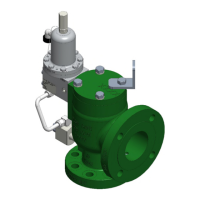INSTALLATION, OPERATION, &
MAINTENANCE MANUAL
TITLE: F7000 / 8000 Series Rev. V
Pilot-Operated Safety Relief Valve Page 14 of 41
4.0 PILOT VALVE MAINTENANCE
4.1 F100 PILOT VALVE (See Illustration on Page 15)
A. F100 Disassembly
CAUTION: It is extremely dangerous to attempt to disassemble any valve while it remains in
service with incoming line pressure.
1) Remove the pilot valve from the main valve, or safely block the incoming pressure before
disassembling the valve and performing maintenance.
2) Unscrew the pressure adjustment screw cap from the pressure adjustment screw. Loosen the lock
nut.
3) Loosen but do not remove the pressure adjustment screw from the pilot valve bonnet.
4) Remove the bolts (also nuts and lockwashers on older bodies) that hold the valve body and bonnet
in place. Separate the bonnet from the body. Remove the spring and two spring washers.
5) With a wrench on the diaphragm lock nut and screwdriver in the top of the spindle, loosen the lock
nut and remove it from the spindle.
6) Remove inner/outer spacer(s) from the top of the valve body. Remove the diaphragm from the
spindle by unscrewing it counter-clockwise.
7) Turn the pilot valve body over and remove the nozzle and spindle. Unscrew the retainer screw
from the spindle. Remove the retainer and seat.
8) Replacement soft goods are listed in Section 8.0 of this manual.
B. F100 Assembly
NOTE: Exercise care in handling softgoods, nozzles, and other sealing surfaces.
1) Confirm pressure setting and associated parts required.
2) Place the valve body in a vise.
3) Apply Loctite 248 to retainer screw. Place the spindle, with the retainer and seat screwed into
place into the valve body, and assemble the nozzle (with seal and O-ring) into the body. Dow
Corning Molykote 33 or equivalent may be used to lubricate O-rings.
4) Carefully assemble the diaphragm to the top of the spindle by slowly turning the diaphragm
clockwise on the spindle threads until it bottoms on the shoulder. Make sure that there are no tears
or rips in the diaphragm material.
5) Apply small amount of Loctite 268 to diaphragm lock nut threads. Assemble inner/outer spacer(s)
and lock nut to the spindle. With a wrench on the nut, and a screwdriver in the top of the spindle,
tighten the parts together. Apply a small drop of Loctite to the nut threads. Make sure that the
spacers are centered to the extent possible.
6) Assemble the spring and spring washers atop the spindle.
7) Assemble the gasket (only if using a Teflon diaphragm) and then the bonnet over the spring and
spring washers onto the top of the diaphragm / body.
8) Apply Loctite 248 to 4 bonnet bolts and insert the bolts through the four holes in the body and bonnet
(washers and nuts also for older bodies).
9) Tighten the bolts to a torque of 5 - 6 ft.-lbs.
10) Insert the pressure adjustment screw into the top of the bonnet and install the lock nut.
11) Attach the pressure adjustment screw cap to the top of the pressure adjustment screw, but do not
tighten down.
12) Insert the inlet screen into the INLET port in the body.
13) Attach the vent / bug screen in the bonnet so that it faces away from the main valve mounting
surface. Face seals should then be positioned on the mounting face.
14) The pilot valve is now completely assembled and ready to be set per Section 5.0.

